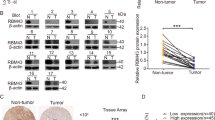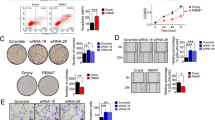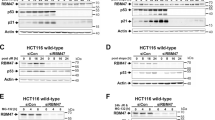Abstract
RNA-binding motif protein 10 (RBM10) is an RNA-binding protein frequently deleted or mutated in lung cancer cells. Recent reports showed that the knockdown of RBM10 in human cancer cells enhances the growth of mouse tumor xenografts, suggesting that RBM10 acts as a tumor suppressor. RBM10 also regulates alternative splicing and controls cancer cell proliferation. However, the underlying molecular mechanisms for its tumor suppression role remain largely unclear. Here, we for the first time report that RBM10 can induce apoptosis and inhibit cancer cell proliferation by activating p53. Our analysis of cancer genomic databases showed that patients with wild-type RBM10 and p53 survive longer than do those with mutated p53 or less RBM10. RBM10 overexpression markedly inhibited mitochondrial respiration, cell migration and proliferation of various cancer cells that harbor wild-type p53. Also, RBM10 overexpression elongated p53’s half-life by disrupting MDM2-p53 interaction and subsequently repressing p53 ubiquitination, whereas knockdown of RBM10 decreased p53 stability. Altogether, our results demonstrate that RBM10 inhibits cancer cell proliferation and induces apoptosis in part by blocking the MDM2-p53 feedback loop.
This is a preview of subscription content, access via your institution
Access options
Subscribe to this journal
Receive 50 print issues and online access
$259.00 per year
only $5.18 per issue
Buy this article
- Purchase on Springer Link
- Instant access to full article PDF
Prices may be subject to local taxes which are calculated during checkout






Similar content being viewed by others
References
Oren M. Decision making byp53: life, death, and cancer. Cell Death Differ. 2003;10:431–42.
Zilfou JT, Lowe SW. Tumor suppressive functions ofp53. Cold Spring Harb Perspect Biol. 2009;1:a001883.
Vousden KH, Lu X. Live or let die: the cell’s response to p53. Nat Rev Cancer. 2002;2:594–604.
Nag S, Qin J, Srivenugopal KS, Wang M, Zhang R. The MDM2-p53 pathway revisited. J Biomed Res. 2013;27:254–71.
Haupt Y, Maya R, Kazaz A, Oren M. Mdm2 promotes the rapid degradation of p53. Nature. 1997;387:296–9.
Kubbutat MH, Jones SN, Vousden KH. Regulation of p53 stability by Mdm2. Nature. 1997;387:299–303.
Honda R, Tanaka H, Yasuda H. Oncoprotein MDM2 is a ubiquitin ligase E3 for tumor suppressor p53. FEBS Lett. 1997;420:25–7.
Yang M, Sun H, Wang H, Zhang S, Yu X, Zhang L. Downregulation of ribosomal protein L22 in non-small cell lung cancer. Med Oncol. 2013;30:646.
Bonnal S, Martinez C, Forch P, Bachi A, Wilm M, Valcarcel J. RBM5/Luca-15/H37 regulates Fas alternative splice site pairing after exon definition. Mol Cell. 2008;32:81–95.
Cao B, Fang Z, Liao P, Zhou X, Xiong J, Zeng S, et al. Cancer-mutated ribosome protein L22 (RPL22/eL22) suppresses cancer cell survival by blocking p53-MDM2 circuit. Oncotarget. 2017;8:90651–61.
Bechara EG, Sebestyen E, Bernardis I, Eyras E, Valcarcel J. RBM5, 6, and 10 differentially regulate NUMB alternative splicing to control cancer cell proliferation. Mol Cell. 2013;52:720–33.
Guan G, Li R, Tang W, Liu T, Su Z, Wang Y, et al. Expression of RNA-binding motif 10 is associated with advanced tumor stage and malignant behaviors of lung adenocarcinoma cancer cells. Tumour Biol. 2017;39:1010428317691740.
Muller PA, Vousden KH, Norman JC. p53 and its mutants in tumor cell migration and invasion. J Cell Biol. 2011;192:209–18.
Sharma N, Jadhav SP, Bapat SA. CREBBP re-arrangements affect protein function and lead to aberrant neuronal differentiation. Differentiation. 2010;79:218–31.
Giebler HA, Lemasson I, Nyborg JK. p53 recruitment of CREB binding protein mediated through phosphorylated CREB: a novel pathway of tumor suppressor regulation. Mol Cell Biol. 2000;20:4849–58.
Zhang Y, Qian Y, Zhang J, Yan W, Jung YS, Chen M, et al. Ferredoxin reductase is critical for p53-dependent tumor suppression via iron regulatory protein 2. Genes Dev. 2017;31:1243–56.
Collins KM, Kainov YA, Christodolou E, Ray D, Morris Q, Hughes T, et al. An RRM-ZnF RNA recognition module targets RBM10 to exonic sequences to promote exon exclusion. Nucleic Acids Res. 2017;45:6761–74.
Lahav G, Rosenfeld N, Sigal A, Geva-Zatorsky N, Levine AJ, Elowitz MB, et al. Dynamics of the p53-Mdm2 feedback loop in individual cells. Nat Genet. 2004;36:147–50.
Hunziker A, Jensen MH, Krishna S. Stress-specific response of the p53-Mdm2 feedback loop. BMC Syst Biol. 2010;4:94.
Zhou X, Liao WJ, Liao JM, Liao P, Lu H. Ribosomal proteins: functions beyond the ribosome. J Mol Cell Biol. 2015;7:92–104.
Liao JM, Zhou X, Gatignol A, Lu H. Ribosomal proteins L5 and L11 co-operatively inactivate c-Myc via RNA-induced silencing complex. Oncogene. 2014;33:4916–23.
Zhou X, Hao Q, Liao J, Zhang Q, Lu H. Ribosomal protein S14 unties the MDM2-p53 loop upon ribosomal stress. Oncogene. 2013;32:388–96.
Dai MS, Lu H. Inhibition of MDM2-mediated p53 ubiquitination and degradation by ribosomal protein L5. J Biol Chem. 2004;279:44475–82.
Jung JH, Liao JM, Zhang Q, Zeng S, Nguyen D, Hao Q, et al. Inauhzin(c) inactivates c-Myc independently of p53. Cancer Biol Ther. 2015;16:412–9.
Acknowledgements
We thank Juan Valcarcel for providing us with RBM10 plasmid, Yongbo Wang for providing us with GFP-RBM10, and Xiang Zhou as well as other members of the Lu laboratory for active discussion. This work was supported in part by National Institutes of Health (NIH)-National Cancer Institute (NCI) grants (R01CA095441, R01CA172468, and R01CA127724) to HL and SXZ.
Author information
Authors and Affiliations
Corresponding author
Ethics declarations
Conflict of interest
The authors declare that they have no conflict of interest.
Additional information
Publisher’s note Springer Nature remains neutral with regard to jurisdictional claims in published maps and institutional affiliations.
Supplementary information
Rights and permissions
About this article
Cite this article
Jung, J.H., Lee, H., Cao, B. et al. RNA-binding motif protein 10 induces apoptosis and suppresses proliferation by activating p53. Oncogene 39, 1031–1040 (2020). https://doi.org/10.1038/s41388-019-1034-9
Received:
Revised:
Accepted:
Published:
Issue Date:
DOI: https://doi.org/10.1038/s41388-019-1034-9
This article is cited by
-
Loss of RPS27a expression regulates the cell cycle, apoptosis, and proliferation via the RPL11-MDM2-p53 pathway in lung adenocarcinoma cells
Journal of Experimental & Clinical Cancer Research (2022)
-
RBM47 inhibits hepatocellular carcinoma progression by targeting UPF1 as a DNA/RNA regulator
Cell Death Discovery (2022)
-
Molecular characterization of ctDNA from Chinese patients with advanced gastric adenocarcinoma reveals actionable alterations for targeted and immune therapy
Journal of Molecular Medicine (2021)



